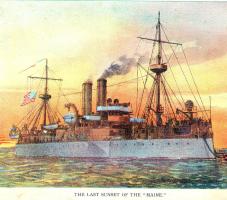 One hundred and twenty years ago today, on February 15, 1898, a mysterious explosion ripped through the hull of the American battleship USS Maine, at anchor in Havana harbor in Cuba. The ship sank killing 266 of the 350 men aboard. The loss of the USS Maine heightened the tension between the United States and Spain. Cuba was a Spanish colony and the island was gripped in a rebellion against Spain. USS Maine was in Havanna to protect U.S. interests.
One hundred and twenty years ago today, on February 15, 1898, a mysterious explosion ripped through the hull of the American battleship USS Maine, at anchor in Havana harbor in Cuba. The ship sank killing 266 of the 350 men aboard. The loss of the USS Maine heightened the tension between the United States and Spain. Cuba was a Spanish colony and the island was gripped in a rebellion against Spain. USS Maine was in Havanna to protect U.S. interests.
It was widely assumed at the time that the Spanish had placed a mine or launched a torpedo which sank the ship. The American press whipped up the American public with the slogan, “Remember the Maine. The Hell with Spain.” After initially attempting to continue with ongoing diplomacy, the US declared war on Spain on April 25, 1898. By August, Spain had ceded Cuba, along with the Philippines, Puerto Rico and Guam, to the United States.
While the sinking of the USS Maine helped in the US’s progression towards war with Spain, to this day, no one is entirely sure what caused the explosion. There have been at least six public and private investigations into the sinking which have reached contradictory conclusions.
The Spanish inquiry found no evidence of a mine and concluded that the most likely cause was the spontaneous combustion in the coal bunker, located adjacent to the munition stores in Maine.
American inquiries in 1898 and 1911, each concluded that a mine had sunk the ship. In 1974, Admiral Hyman G. Rickover began a new investigation. Based on new engineering analysis, Rickover’s team agreed with the Spanish that the most likely cause was a spontaneous combustion in the coal bunker.
Private investigations sponsored by National Geographic and the Discovery Channel in 1998 and 2002, respectively yielded mixed results. The National Geographic investigation was inconclusive, developing evidence for an internal explosion in the coal bunker and an external blast from a mine. The Discovery Channel investigation sided with Rickover and the Spanish, that a bunker explosion was the most likely cause.
A final conspiracy theory is that the US sank its own warship to trigger a conflict with Spain. Like so many conspiracy theories, it is unsupported by any real evidence.
Between 1910 and 1912, the wreckage of the USS Maine was raised from Havanna harbor by the US Army Corps of Engineers. The remaining 66 bodies of lost crew were removed for burial. On March 16, 1912, Maine was towed four miles from the Cuban coast and sunk.

The adorning casting of the Battleship Maine is on a monument in Bangor Maine. A picture of it can be seen at
http://www.spanamwar.com/mainebowscrollfront.JPG
There was a bronze porthole from the “Maine” punched through a wall of one of the rooms of the Officers’ Club on Governors Island in New York Harbor. We saw it during our son’s wedding reception that was held there in the early ’90s. As I remember, it looked the worse for wear, with the bronze and glass scratched. I have no idea if it is still there, since G.I. is no longer a Coast Guard base, but a New York City park.
The Maine had been outfitted with Worthington steam pumps. Although lying on the bottom of Havana Harbor for fourteen years these pumps were found to be still operational, and were subsequently used to raise the ship.[
We had a similar disaster on the River Medway in SE England. HMS Bulwark exploded on her mooring with tremendous loss of life in 1914. Then a few months later the HMS Princess Irene also exploded whilst loading munitions, again with many lives lost.
HMS Bulwark is a war grave but for some reason HMS Princess Irene is not. Maybe because she sank in the vicinity of what is now a container port and they wanted to dredge the site.
Going way back, there was the loss of the London the Thames in 1665 due an explosion.